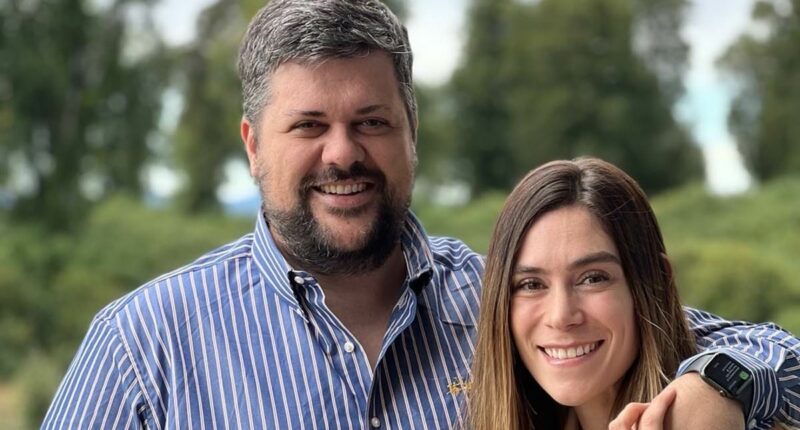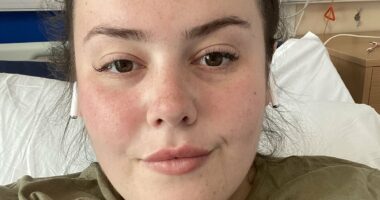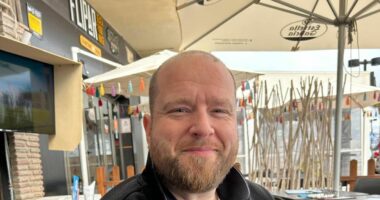Share this @internewscast.com
Five years ago, Jeremy Cabral faced a concerning reality: his weight and lifestyle choices were jeopardizing his future, threatening to steal away cherished moments with his young family.
At over 140 kilograms (22 stone), the Sydney father of two was not only grappling with exhaustion but was also enduring chronic back pain, sciatica, and sleep apnea.
Even simple everyday activities, like climbing stairs, became a painful challenge for him.
Jeremy, who at 39 had a biological age of 44.2, blamed his declining health on an overbearing work-life balance. As the co-founder of Finder, Australia’s largest financial comparison website, he often worked up to 18 hours per day.
“I was in so much pain, I feared I wouldn’t even be able to hold my baby girls when they were born,” Jeremy reflects.
Last year, after relocating to the United States with his family for nine months, Jeremy noticed his health symptoms deteriorating rapidly.
‘I was working around the clock, seven days a week, sleeping on average three hours a night. My girls were only 13 months old at the time. I had massive energy issues and drank so much caffeine. I used to wake up feeling like I’d been hit by a truck.
‘I’d jump on a 5.30am call, feed the girls at 7am, have a quick nap then start working again. I was so burnt out.

Sydney businessman Jeremy Cabral (left, with his wife) suffered from exhaustion, back pain, sciatica and chronic sleep apnoea due to his weight
‘I would have a meal, have another coffee. If that didn’t work, I’d have an energy drink… then I’d need sugar instead. Then I’d go back through the cycle.’
Jeremy knew something had to change, but not through fads or expensive ‘hacks’.
The catalyst came in December last year when he set himself an ambitious goal: to run a marathon.
Rather than seek shortcuts, Jeremy decided to experiment with ‘everyday biohacking’ – accessible lifestyle tweaks that can lower your biological age and improve health without resorting to costly extremes.
He focused on simple changes: sleep, food, movement and smart use of technology.
A sports scientist warned him bluntly: ‘You’re too fat to run a marathon. You could have a heart attack and should aim for 10km instead.’
Rather than give up, Jeremy saw this as a challenge.
‘It made no sense physically, but I was determined. When people started to doubt me, it lit a fire inside me to prove them wrong. I knew I had to take a data-led approach and build myself a support team.’

In April, Jeremy tipped the scales at 127.5kg but by August he weighed 107.5kg
Jeremy jumpstarted his new lifestyle with a ten-day water fast – abstaining from all food and other beverages, consuming only water – but credits the real progress to less radical, daily changes.
Serendipity connected him with Ben Lucas, the coach of the Sydney marathon, at a local café, and Jeremy recruited Ben to train him.
From December, Jeremy committed to a data-driven training plan and enlisted a nutritionist, personal trainer and physiotherapist. He also used a Whoop exercise band to track his training load, sleep quality and VO2 max – a key marker for endurance.
‘I wanted to be an example for my daughters, to show them that just because something hasn’t been done yet, doesn’t mean it’s not possible.’
Jeremy also incorporated technology and AI, using ChatGPT to generate more than 3,000 prompts, feeding it data from his training sessions, blood tests and gut microbiome results for tailored advice on supplements and nutrition.
‘I’d take the AI advice to my experts to verify – I never relied solely on it,’ he said.

‘You’re too fat to run a marathon. You could have a heart attack and should aim for 10km instead,’ a sports scientist told Jeremy. But he was determined to prove them wrong

The term ‘biohacking’ is associated with tech mogul Bryan Johnson (right, with son Talmage). But there are ways to slow or even reverse biological age without resorting to extremes
How everyday biohacking helped Jeremy lose 20kg and run a marathon
Nutrition
Working with a nutritionist, Jeremy tailored his diet and supplements, focusing on gut health with 30+ plant varieties a week, boosting protein and managing carbs. He practised water fasting and protein-only fasts – common biohacks to accelerate fat loss – and carb-loaded for endurance.
‘It got to April and I started ramping up with a plan to lose 5kg a month. Otherwise it would’ve been scientifically near impossible. I stopped treating my health like a side project and started treating it like a mission,’ he said.
Movement
Jeremy trained with Ben Lucas using run-walk intervals, gradually increasing pace and distance. He focused on simple daily goals such as aiming for 15,000 steps a day.
Jeremy trained three times a week, did as many strength sessions as possible and fuelled his body for recovery and performance. Over four months, he ran five half-marathons, mostly on treadmills – another efficiency biohack to reduce injury risk.
Tracking and recovery
A Whoop band – similar to a Fitbit – tracked his VO2 max and sleep. Recovery protocols (ice baths, scheduled rest) helped him avoid injury and burnout. He structured workouts around recovery data, using technology as a guide.
Sleep
Jeremy tackled sleep apnoea with a CPAP machine and complementary lifestyle changes, while also prioritising sleep for recovery, energy and fat loss. Sleep-tracking devices helped him measure and improve rest.
Mindset
He kept himself moving with techniques such as running to a metronome, saving his favourite music for the last stretch, and singing out loud to stay focused.
By August, Jeremy weighed 107.5kg (17st). On a rain-soaked Sunday, he ran the full Sydney marathon with a friend, smashing his goal.
He described the last kilometres as ‘brutal’, but the sight of his wife and daughters cheering him on helped him dig deep.
Jeremy, whose biological age has now dropped to 41, says he is a testament to the power of everyday biohacking and using simple, daily habits to radically transform health and life.
‘Your body is not your limitation, your mind is. You can make the impossible possible.’

















